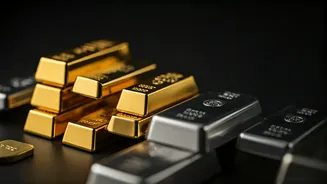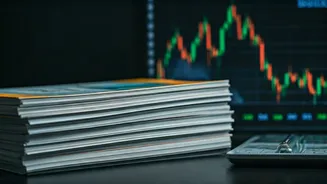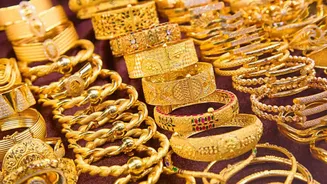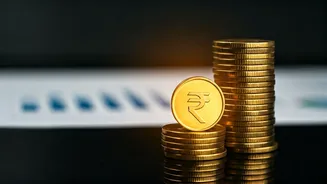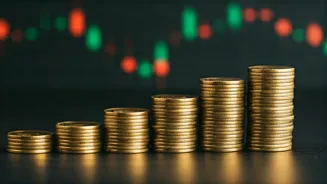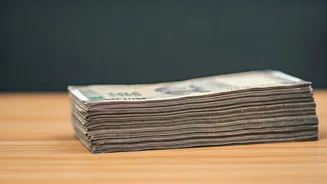Gold ETF Basics
Gold Exchange Traded Funds (ETFs) provide a convenient way to invest in gold without directly owning physical gold. These funds trade on stock exchanges,
and their value is primarily linked to the price of gold. Investors can buy and sell ETF shares during market hours, providing liquidity. Gold ETFs track the performance of gold, offering an easy method to diversify portfolios with precious metals. Gold is often seen as a safe haven asset and a hedge against inflation. This makes Gold ETFs attractive, especially during times of economic uncertainty. They provide a transparent and cost-effective way to get exposure to gold, with expense ratios generally being lower than traditional methods such as buying physical gold or investing in gold mining companies. Additionally, Gold ETFs eliminate the need for storage and insurance, associated with physical gold, adding to their appeal. In the Indian market, where the demand for gold has been traditionally high, Gold ETFs present a popular investment avenue.
Silver ETF Dynamics
Silver ETFs, mirroring Gold ETFs, offer a route to invest in silver without directly purchasing physical silver. These ETFs trade on exchanges, mirroring the silver market prices. Unlike gold, silver has both investment and industrial applications, making its price more volatile. The industrial use of silver, in electronics and manufacturing, can significantly impact its price based on the demand in these sectors. Silver ETFs provide similar advantages as Gold ETFs, including liquidity, cost-effectiveness, and the elimination of storage and insurance costs. However, silver prices tend to be more sensitive to economic cycles and industrial production fluctuations, potentially exposing investors to higher volatility. Investors must consider these factors when assessing Silver ETFs. In India, silver ETFs are available, providing a means to participate in the silver market. It’s important to research and compare different silver ETFs, assessing their expense ratios and the accuracy of their tracking of the silver price.
Performance Comparisons
Comparing the performance of Gold and Silver ETFs often reveals contrasting patterns, reflecting their inherent differences. Gold, historically a more stable asset, often demonstrates more consistent, though typically lower, returns compared to silver. Silver's price can experience higher volatility due to its broader industrial application, resulting in periods of significant gains and losses. Examining historical data is crucial. During periods of economic downturn, gold often performs well as investors seek safe havens. Conversely, silver may underperform if industrial demand falters. Over extended periods, both metals have shown potential for growth, yet their returns are shaped by a complex interplay of market sentiment, inflation, currency fluctuations, and industrial demand. Investors should analyze market cycles and economic indicators to understand these performance disparities. It is advisable to review the ETFs' past performance, comparing their returns against benchmarks to gauge how well they track the metal prices.
Risk Factor Analysis
Understanding the risk factors linked with Gold and Silver ETFs is vital for sound investment decisions. Gold, though generally considered a safe haven, isn't risk-free. Risks include price volatility, currency fluctuations (especially when the gold is priced in a different currency than the investor's), and macroeconomic factors like inflation and interest rate changes. Silver ETFs exhibit higher risk profiles. Silver's price is sensitive to industrial demand, economic cycles, and supply-demand imbalances, leading to elevated volatility. Additionally, market sentiment and global events can affect both gold and silver prices. The risk associated with the ETF provider, such as operational risks or tracking errors, also needs consideration. Investors must conduct thorough due diligence, assessing the risks associated with both metals. Considering the investment horizon, risk tolerance, and diversification objectives is essential. Consult with a financial advisor for a personalized assessment of these risks.
Investment Strategies
Different investment strategies are suitable for Gold and Silver ETFs, based on your risk tolerance and financial goals. Gold ETFs are often used for portfolio diversification and as hedges against inflation. A 'buy-and-hold' strategy works well, especially for those seeking long-term value preservation. Silver ETFs can offer higher growth potential but come with increased risk. Investors might adopt strategies that are more active, such as tactical asset allocation, where they adjust their holdings based on market forecasts. Dollar-cost averaging, investing a fixed amount regularly, is an effective way to mitigate the impact of market volatility. Both Gold and Silver ETFs can form part of a diversified portfolio, balanced with other assets like stocks, bonds, and real estate. To construct an appropriate strategy, define your investment objectives, risk tolerance, and time horizon. Rebalance your portfolio periodically to maintain the desired asset allocation. A financial advisor can offer insights tailored to your specific situation and needs.
Market Outlook for India
In the Indian market, both Gold and Silver ETFs hold unique significance. Gold has a deep-rooted cultural importance in India, driving consistent demand. Silver also enjoys popularity, used in jewelry and industrial applications. The current market outlook for both metals hinges on global economic trends, currency rates, and domestic demand dynamics. Indian government policies, trade regulations, and import duties can significantly impact prices. The depreciation of the rupee against the US dollar affects the cost of imported precious metals. Therefore, currency fluctuations should be carefully monitored. Analyze inflation rates and interest rate movements, as these can impact the appeal of precious metals as a hedge. The increasing adoption of ETFs among Indian investors indicates a growing awareness and acceptance of these investment vehicles. When evaluating Gold and Silver ETFs, consider factors such as expense ratios, liquidity, and past performance. Stay updated on market developments through reliable financial news sources.
